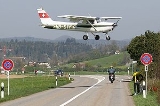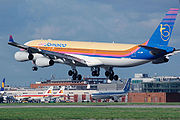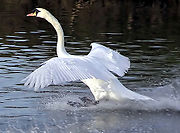
Landing
Encyclopedia



Flight
Flight is the process by which an object moves either through an atmosphere or beyond it by generating lift or propulsive thrust, or aerostatically using buoyancy, or by simple ballistic movement....
, where a flying animal
Animal
Animals are a major group of multicellular, eukaryotic organisms of the kingdom Animalia or Metazoa. Their body plan eventually becomes fixed as they develop, although some undergo a process of metamorphosis later on in their life. Most animals are motile, meaning they can move spontaneously and...
, aircraft
Aircraft
An aircraft is a vehicle that is able to fly by gaining support from the air, or, in general, the atmosphere of a planet. An aircraft counters the force of gravity by using either static lift or by using the dynamic lift of an airfoil, or in a few cases the downward thrust from jet engines.Although...
, or spacecraft
Spacecraft
A spacecraft or spaceship is a craft or machine designed for spaceflight. Spacecraft are used for a variety of purposes, including communications, earth observation, meteorology, navigation, planetary exploration and transportation of humans and cargo....
returns to the ground. When the flying object returns to water, the process is called alighting, although it is commonly called "landing" and "touchdown" as well. A normal aircraft flight would include several parts of flight including taxi
Taxiing
Taxiing refers to the movement of an aircraft on the ground, under its own power, in contrast to towing or push-back where the aircraft is moved by a tug...
, takeoff
Takeoff
Takeoff is the phase of flight in which an aerospace vehicle goes from the ground to flying in the air.For horizontal takeoff aircraft this usually involves starting with a transition from moving along the ground on a runway. For balloons, helicopters and some specialized fixed-wing aircraft , no...
, climb
Climb
thumb|right|An [[Embraer ERJ 145]] climbingIn aviation, the term climb refers both to the actual operation of increasing the altitude of an aircraft and to the logical phase of a typical flight following take-off and preceding the cruise, during which an increase in altitude to a predetermined...
, cruise
Cruise (flight)
Cruise is the level portion of aircraft travel where flight is most fuel efficient. It occurs between ascent and descent phases and is usually the majority of a journey. Technically, cruising consists of heading changes only at a constant airspeed and altitude...
, descent
Descent (aircraft)
A descent during air travel is any portion where an aircraft decreases altitude, and is the opposite of an ascent or climb. Descents are an essential component of an approach to landing...
and landing.
Aircraft
Aircraft usually land at an airportAirport
An airport is a location where aircraft such as fixed-wing aircraft, helicopters, and blimps take off and land. Aircraft may be stored or maintained at an airport...
on a firm runway
Runway
According to ICAO a runway is a "defined rectangular area on a land aerodrome prepared for the landing and take-off of aircraft." Runways may be a man-made surface or a natural surface .- Orientation and dimensions :Runways are named by a number between 01 and 36, which is generally one tenth...
or helicopter landing pad, generally constructed of asphalt concrete
Asphalt concrete
Asphalt concrete is a composite material commonly used in construction projects such as road surfaces, airports and parking lots. It consists of asphalt and mineral aggregate mixed together, then laid down in layers and compacted...
, concrete
Concrete
Concrete is a composite construction material, composed of cement and other cementitious materials such as fly ash and slag cement, aggregate , water and chemical admixtures.The word concrete comes from the Latin word...
, gravel or grass. Aircraft equipped with pontoons (floatplane
Floatplane
A floatplane is a type of seaplane, with slender pontoons mounted under the fuselage; only the floats of a floatplane normally come into contact with water, with the fuselage remaining above water...
) or with a boat hull-shaped fuselage (a flying boat
Flying boat
A flying boat is a fixed-winged seaplane with a hull, allowing it to land on water. It differs from a float plane as it uses a purpose-designed fuselage which can float, granting the aircraft buoyancy. Flying boats may be stabilized by under-wing floats or by wing-like projections from the fuselage...
) are able to land on water. Aircraft also sometimes use skis to land on snow or ice.
To land, the airspeed and the rate of descent are reduced such that the object descends at a slow enough rate to allow for a gentle touch down. Landing is accomplished by slowing down and descending to the runway. This speed reduction is accomplished by reducing thrust and/or inducing a greater amount of drag using flaps, landing gear or speed brakes
Air brake (aircraft)
In aeronautics, air brakes or speedbrakes are a type of flight control surface used on an aircraft to increase drag or increase the angle of approach during landing....
. When a fixed wing aircraft approaches the ground, the pilot will move the control column back to execute a flare or round-out. This increases the angle of attack
Angle of attack
Angle of attack is a term used in fluid dynamics to describe the angle between a reference line on a lifting body and the vector representing the relative motion between the lifting body and the fluid through which it is moving...
. Progressive movement of the control column back will allow the aircraft to settle onto the runway at minimum speed, landing on its main wheels first in the case of a tricycle gear
Tricycle gear
Tricycle gear describes an aircraft undercarriage, or landing gear, arranged in a tricycle fashion. The tricycle arrangement has one wheel in the front, called the nose wheel, and two or more main wheels slightly aft of the center of gravity...
aircraft or on all three wheels simultaneously in the case of a conventional landing gear
Conventional landing gear
thumb|The [[Piper PA-18|Piper Super Cub]] is a popular taildragger aircraft.thumb|right|A [[Cessna 150]] converted to taildragger configuration by installation of an after-market modification kit....
-equipped aircraft, commonly referred to as a "taildragger". This is known as flaring.
Light aircraft
In a light aircraftLight aircraft
A light aircraft is an aircraft that has a maximum gross take-off weight of or less.Many aircraft used commercially for freight, sightseeing, photography and scheduled flights are light aircraft.Examples of light aircraft include:...
, with little crosswind
Crosswind
A crosswind is any wind that has a perpendicular component to the line or direction of travel. In aviation, a crosswind is the component of wind that is blowing across the runway making landings and take-offs more difficult than if the wind were blowing straight down the runway...
, the ideal landing is when contact with the ground occurs as the forward speed is reduced to the point where there is no longer sufficient airspeed to remain aloft. The stall
Stall (flight)
In fluid dynamics, a stall is a reduction in the lift coefficient generated by a foil as angle of attack increases. This occurs when the critical angle of attack of the foil is exceeded...
warning is often heard just before landing, indicating that this speed and altitude have been reached. The result is very light touch down.
Light aircraft landing situations, and the pilot skills required, can be divided into four types:
- Normal landings
- Crosswind landings - where a significant wind not aligned with the landing area is a factor
- Short field landings - where the length of the landing area is a limiting factor
- Soft and unprepared field landings - where the landing area is wet, soft or has ground obstacles such as furrows or ruts to contend with
Large aircraft
In large transport categoryTransport category
Transport category is a category of airworthiness applicable to large civil airplanes and large civil helicopters. Any aircraft's airworthiness category is shown on its airworthiness certificate...
(airliner) aircraft, pilots land the aircraft by "flying the airplane on to the runway." The airspeed and attitude of the plane are adjusted for landing. The airspeed is kept well above stall speed and at a constant rate of descent. A flare is performed just before landing, and the descent rate is significantly reduced, causing a light touch down. Upon touchdown, spoilers (sometimes called "lift dumpers") are deployed to dramatically reduce the lift and transfer the aircraft's weight to its wheels, where mechanical braking, such as an autobrake
Autobrake
An autobrake is a type of automatic wheel-based hydraulic brake system for advanced airplanes. The autobrake is normally enabled during takeoff and landing procedures, when the aircraft's longitudinal deceleration system can be handled by the automated systems of the aircraft itself in order to...
system, can take effect. Reverse thrust is used by many jet aircraft
Jet aircraft
A jet aircraft is an aircraft propelled by jet engines. Jet aircraft generally fly much faster than propeller-powered aircraft and at higher altitudes – as high as . At these altitudes, jet engines achieve maximum efficiency over long distances. The engines in propeller-powered aircraft...
to help slow down just after touch-down, redirecting engine exhaust forward instead of back. Some propeller
Propeller (aircraft)
Aircraft propellers or airscrews convert rotary motion from piston engines or turboprops to provide propulsive force. They may be fixed or variable pitch. Early aircraft propellers were carved by hand from solid or laminated wood with later propellers being constructed from metal...
-driven airplanes also have this feature, where the blades of the propeller are re-angled to push air forward instead of back using the 'beta range'.
Environmental factors
Factors such as crosswindCrosswind
A crosswind is any wind that has a perpendicular component to the line or direction of travel. In aviation, a crosswind is the component of wind that is blowing across the runway making landings and take-offs more difficult than if the wind were blowing straight down the runway...
where the pilot will use a crab landing or a slip landing will cause pilots to land slightly faster and sometimes with different aircraft attitude to ensure a safe landing.
Other factors affecting a particular landing might include: the plane size, wind
Wind
Wind is the flow of gases on a large scale. On Earth, wind consists of the bulk movement of air. In outer space, solar wind is the movement of gases or charged particles from the sun through space, while planetary wind is the outgassing of light chemical elements from a planet's atmosphere into space...
, weight
Weight
In science and engineering, the weight of an object is the force on the object due to gravity. Its magnitude , often denoted by an italic letter W, is the product of the mass m of the object and the magnitude of the local gravitational acceleration g; thus:...
, runway length, obstacles, ground effects, weather
Weather
Weather is the state of the atmosphere, to the degree that it is hot or cold, wet or dry, calm or stormy, clear or cloudy. Most weather phenomena occur in the troposphere, just below the stratosphere. Weather refers, generally, to day-to-day temperature and precipitation activity, whereas climate...
, runway altitude, air temperature, air pressure
Atmospheric pressure
Atmospheric pressure is the force per unit area exerted into a surface by the weight of air above that surface in the atmosphere of Earth . In most circumstances atmospheric pressure is closely approximated by the hydrostatic pressure caused by the weight of air above the measurement point...
, air traffic control
Air traffic control
Air traffic control is a service provided by ground-based controllers who direct aircraft on the ground and in the air. The primary purpose of ATC systems worldwide is to separate aircraft to prevent collisions, to organize and expedite the flow of traffic, and to provide information and other...
, visibility
Visibility
In meteorology, visibility is a measure of the distance at which an object or light can be clearly discerned. It is reported within surface weather observations and METAR code either in meters or statute miles, depending upon the country. Visibility affects all forms of traffic: roads, sailing...
, avionics
Avionics
Avionics are electronic systems used on aircraft, artificial satellites and spacecraft.Avionic systems include communications, navigation, the display and management of multiple systems and the hundreds of systems that are fitted to aircraft to meet individual roles...
and the overall situation.
For example, landing a multi-engine turboprop
Turboprop
A turboprop engine is a type of turbine engine which drives an aircraft propeller using a reduction gear.The gas turbine is designed specifically for this application, with almost all of its output being used to drive the propeller...
military such as a C-130 Hercules
C-130 Hercules
The Lockheed C-130 Hercules is a four-engine turboprop military transport aircraft designed and built originally by Lockheed, now Lockheed Martin. Capable of using unprepared runways for takeoffs and landings, the C-130 was originally designed as a troop, medical evacuation, and cargo transport...
, under fire in a grass field in a war zone, requires different skills and precautions than landing a single engine plane such as a Cessna 150
Cessna 150
The Cessna 150 is a two-seat tricycle gear general aviation airplane, that was designed for flight training, touring and personal use.The Cessna 150 is the seventh most produced civilian plane ever, with 23,839 aircraft produced...
on a paved runway in uncontrolled airspace, which is different from landing an airliner such as a Airbus A380
Airbus A380
The Airbus A380 is a double-deck, wide-body, four-engine jet airliner manufactured by the European corporation Airbus, a subsidiary of EADS. It is the largest passenger airliner in the world. Due to its size, many airports had to modify and improve facilities to accommodate it...
at a major airport with air traffic control
Air traffic control
Air traffic control is a service provided by ground-based controllers who direct aircraft on the ground and in the air. The primary purpose of ATC systems worldwide is to separate aircraft to prevent collisions, to organize and expedite the flow of traffic, and to provide information and other...
.
Parachutes
The term "landing" is also applied to people or objects descending to the ground using a parachuteParachute
A parachute is a device used to slow the motion of an object through an atmosphere by creating drag, or in the case of ram-air parachutes, aerodynamic lift. Parachutes are usually made out of light, strong cloth, originally silk, now most commonly nylon...
. Some consider these objects to be in a controlled descent instead of actually flying. Most parachutes work by capturing air, inducing enough drag that the falling object hits the ground at a relatively slow speed. There are many examples of parachutes in nature, including the seeds of a dandelion.
On the other hand, modern ram-air parachutes are essentially inflatable wings that operate in a gliding flight mode. Parachutists execute a flare at landing, reducing or eliminating both downward and forward speed at touchdown, in order to avoid injury.
Rockets
Sometimes, a safe landing is accomplished by using multiple forms of lift, thrust and dampening systems. The Apollo Lunar ModuleApollo Lunar Module
The Apollo Lunar Module was the lander portion of the Apollo spacecraft built for the US Apollo program by Grumman to carry a crew of two from lunar orbit to the surface and back...
used a rocket and landing gear to land on the moon. Several Soviet rockets including the Soyuz spacecraft
Soyuz spacecraft
Soyuz , Union) is a series of spacecraft initially designed for the Soviet space programme by the Korolyov Design Bureau in the 1960s, and still in service today...
have used parachutes and airbag landing systems to dampen the landing on earth.
See also
- Arresting gearArresting gearArresting gear, or arrestor gear, is the name used for mechanical systems designed to rapidly decelerate an aircraft as it lands. Arresting gear on aircraft carriers is an essential component of naval aviation, and it is most commonly used on CATOBAR and STOBAR aircraft carriers. Similar systems...
- Crosswind landingCrosswind landingA crosswind landing is a landing maneuver in which a significant component of the prevailing wind is perpendicular to the runway center line.-Significance:Aircraft in flight are subject to the direction of the winds in which the aircraft is operating...
- Landing flareLanding flareThe landing flare is a maneuver or stage during the landing of an aircraft. The nose of the plane is raised, slowing the descent rate, and the proper attitude is set to prepare for touchdown. In parachuting, the landing flare is the part of the parachute landing fall preceding ground contact, and...
- Landing performanceLanding performanceThe performance data for landing an aircraft can be obtained from the aircraft's flight manual or pilot's operating Handbook. The actual landing performance of an aircraft is affected by many variables which must be taken into account.-Weight:...

